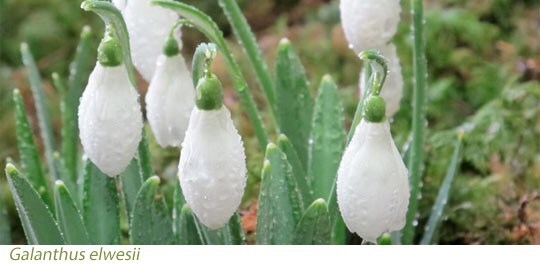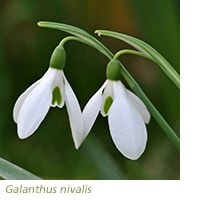Start the display early
Early Bloomers for Partial Shade

When planning your spring bulb display, try to include some of the earliest flowering bulbs, including a ground-hugging scilla with an impossible Russian name - Scilla mischtschenkoana. This miniature bulb, originally collected in the 1930s, will flower with the snowdrops and aconites, like a snowflake against the bare earth. Looking best in shade, it’s not planted nearly enough.
 Make sure you find room for the snowdrop and the winter aconite as well. The boldest snowdrop of all is Galanthus elwesii. Its glaucous, blunt-topped leaves indicate a preference for a brighter spot to promote early flowers, so a woodland edge or an open position is best. The handsome green markings on the single flowers, which often appear in January, are variable, adding further interest. And the large bulbs increase well too.
Make sure you find room for the snowdrop and the winter aconite as well. The boldest snowdrop of all is Galanthus elwesii. Its glaucous, blunt-topped leaves indicate a preference for a brighter spot to promote early flowers, so a woodland edge or an open position is best. The handsome green markings on the single flowers, which often appear in January, are variable, adding further interest. And the large bulbs increase well too.
Most people will long to grow our most common snowdrop Galanthus nivalis. This is more of a woodlander, preferring cool shade. There are elegant single forms and frilly doubles labelled 'Flore Pleno'. Their frilly middles force them to stay open, even on the dullest day. So although double flowered forms may not have the simple elegance of the singles, they do make more of a splash. A giant hybrid that can reach a foot in height,
'S. Arnott’, has pearl earrings for flowers, which when they open, smell of honey.
Early Flowering Sun Lovers
Add winter aconites (Eranthis hyemalis) too, but do find them a sunny and sheltered spot so that they open their flowers for the bees. Pollination will produce plump star-shaped capsules full of seeds and these will eventually produce a natural colony.
 The smaller-flowered crocus are never far behind the winter aconites and they share a love of sun. One jaunty little crocus combines purple petals ringed in white and egg-yolk yellow - Crocus sieberi subsp. sublimis 'Tricolor'. This could ring a tree, or pop up on a sunny corner and it has a charming habit of peeping through snow.
The smaller-flowered crocus are never far behind the winter aconites and they share a love of sun. One jaunty little crocus combines purple petals ringed in white and egg-yolk yellow - Crocus sieberi subsp. sublimis 'Tricolor'. This could ring a tree, or pop up on a sunny corner and it has a charming habit of peeping through snow.
Shortly afterwards the many forms of small-flowered crocus appear and many have flamed outer petals to their tiny pastel-tinted flowers. Use these in warm, well-drained spots where the sun strikes. A mixed species packet will give you a toning selection of several varieties.
Larger crocus generally flower four weeks after the smaller crocus. They are bred from an alpine species, Crocus vernus, and are strong enough to be naturalised in grass. The truly beautiful 'Vanguard’ is much earlier, hence the name, and this vision of lilac and silver usually appears in February. It’s one bulb every gardener should grow, but it wasn’t available for many years. Take advantage now.






